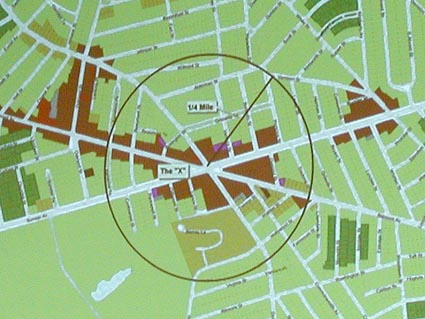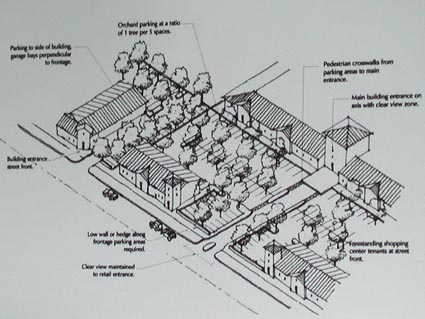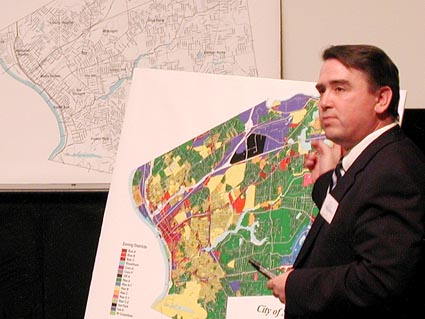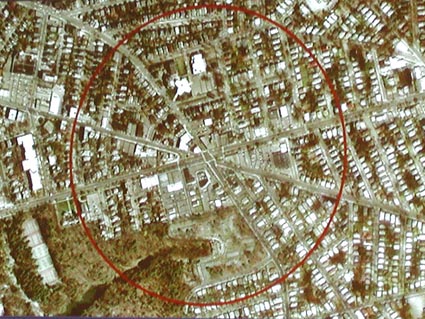 A December 14 press advisory from Springfield’s Office of Planning and Economic Development shed light on a few details emerging from the zoning ordinance (PDF) revision project first presented last April by Lexington-based consultant Chris Eaton and colleagues. The project is taking a little longer than officials and consultants may have first anticipated, with a cohesive announcement to the public looking more likely toward early spring. One of the chief milestones since the consultants were hired is the Urban Land Institute panel visit last September.
A December 14 press advisory from Springfield’s Office of Planning and Economic Development shed light on a few details emerging from the zoning ordinance (PDF) revision project first presented last April by Lexington-based consultant Chris Eaton and colleagues. The project is taking a little longer than officials and consultants may have first anticipated, with a cohesive announcement to the public looking more likely toward early spring. One of the chief milestones since the consultants were hired is the Urban Land Institute panel visit last September.
At the April 26 presentation, the leading two-fold purpose of the project was described as clarity: on one hand, the intent is to make the zoning ordinance and subdivision regulation easier to understand and use. Residents and businesses need to be able to navigate the rules, too, not just officials. On the other hand, there is emphasis on the revision process itself, effectively capturing "community goals" in the results. Community goals might include concerns like density, aesthetics, environment and economy; residents don’t necessarily use these terms, but the consultants can help translate.
The community, city officials and consultants are making headway on revising the ordinances, the planning office says, claiming that the current draft of the revision—roughly halfway complete—includes "greater usability for property owners and support for neighborhood initiatives." Since July, a community advisory committee has met seven times to examine the proposed changes and offer suggestions, working to develop "a fully revamped Zoning Ordinance in an effort to maximize the potential of its commercial and residential areas."
The planning office indicated that a public draft will be released this spring, and described the advisory committee as a group of "neighborhood representatives, business people, Planning Board members and the regional planning commission." The consultants’ participation "was made possible by a $90,000 grant from the Commonwealth’s Executive Office of Environmental Affairs."
The committee’s membership is Kathy Brown of East Springfield (attended 4 meetings of 7), Timothy Brennan of PVPC (7), Jose Claudio of New North Citizens’ Council (0), developer Frank Colaccino (4), Clodo Concepcion of Sixteen Acres (3), Gloria DeFilipo of Pine Point (4), Russell Denver of the Chambers of Commerce (5), architect and business owner Kerry Dietz of Forest Park (7), a certain Francis Fitzgerald (0), attorney Ellen Freyman of Longmeadow (7), Peter Gagliardi of HAP, Inc. (6), Linda Langevin of Six Corners (5), Historic Commission chair Robert McCarroll of downtown (7), City Councilor and business manager Bruce Stebbins of downtown (5), and Patricia Triggs of Forest Park (3). Realtor Liam Reynolds, invited to serve on the committee, declined to participate.
The city’s Planning Board was also invited to attend meetings at their discretion. Of those, Ben Swan, Jr. of Hill-McKnight (3), Geraldine Gardiner of Hill-McKnight (2), Norma Villanueva of Forest Park (1) and Barbara Footit of East Forest Park (1) all opted to take up the invitation at least once. Four others did not.

The purpose of the revision project is not just clarity and community participation. It’s also to improve the zoning ordinance, to modernize and streamline it, bringing it up to speed with today’s world. Conflicting auto uses, for instance, will be addressed and better regulated. Improvements will be made that enhance, rather than inhibit, opportunities for economic development.
"More than a reshuffling of technical compliance matters," the planning office says, "the new Zoning Ordinance is intended to cultivate the neighborhoods within the city by making it easier for owners of businesses and residences to improve their properties and benefit from the improvement of properties around them."
When the ULI panel visited, it made recommendations that impact the zoning revision project. According to the planning office, "[T]he Urban Land Institute [recommended] that the special permit process be moved to the jurisdiction of the Planning Board [instead of the City Council]; other permitting changes include modifying site plan review protocols to expedite the process of property development."
While the above is understated and level-headed, it also seems revolutionary. Effective site plan review—which enables the city to follow up on projects, hold developers accountable, and make sure their brick-and-mortar plans comply with all levels of design and development plans—could be considered the keystone element in a project. It’s like putting a period at the end of a sentence. As far as I understand, Springfield currently has no site plan review protocols to "modify." Is it perhaps correct to say they need to be "created"?
 "An additional example of the new Zoning Ordinance is the consolidation of land uses into one table set out in the ordinance," says the planning office. According to Deputy Planning Director Philip Dromey, the easy-reference chart "will enable people to go to one place in the ordinance instead of having to hunt through many Articles to find information. This change is a tremendous improvement over the current structure."
"An additional example of the new Zoning Ordinance is the consolidation of land uses into one table set out in the ordinance," says the planning office. According to Deputy Planning Director Philip Dromey, the easy-reference chart "will enable people to go to one place in the ordinance instead of having to hunt through many Articles to find information. This change is a tremendous improvement over the current structure."
The revision will also modify neighborhood commercial "overlay district" standards, newly applying them to business districts in the South End and Indian Orchard. At the moment, such standards apply only at the X, the Forest Park business district. According to a helpful document (PDF) from Georgia about corridor development, an overlay district is a special zone placed "on top" of existing regulations. From the document:
The overlay district contains requirements that either supplement or replace the underlying regulations. This approach allows local governments to maintain current codes while addressing the special needs of particularly sensitive areas. This is an attractive option for communities wishing to revitalize a particular strip corridor without more extensive amendments to the jurisdiction’s underlying zoning ordinance.
Consultant Eaton said that the two new districts selected for the overlay were chosen by the members of the advisory committee themselves, strikingly so because none of them lives in Indian Orchard, for example. There was a strong urge to preserve the character of those two neighborhood business districts, perhaps as a beginning point for possible expansion in the future of the overlay approach, which brings on stricter standards for appearance and function that have to be upheld and monitored.

At the April presentation, points were made about why the zoning revision is so important for Springfield. It comes down to a lack of certainty and direction, primarily for developers interested in generating new business in the city or creating infill housing. The current zoning districts may provide too little direction to developers, and the land use and permit processes may be surrounded by a cloud of uncertainty, inhibiting investment. Aesthetically speaking, the city’s commercial districts have few, if any, design standards to help maintain some consistency in appearance and use.
As Chief Development Officer David Panagore said, "Community character matters in our city. We want zoning standards and policies to enhance that character instead of standing in the way."


